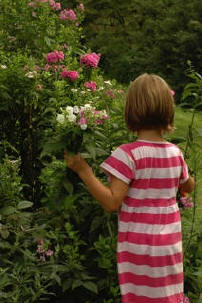(8/1) One of my favorite Great Aunts, Pankie, was a principal at an elementary school. Pankie used to say that when she saw goldenrod blooming, she knew it would soon be time to go back to school. I can’t see goldenrod without generating a back to school list.
As a gardener, seeing goldenrod also tickles that part of my brain that opens my mind’s eye to images of fall harvests of carrots, beets, and kale- the crops I am planning now. Like many gardeners, I tend to have one week in the late spring, usually after Mother’s Day, when I do intensive planting of all my heat loving summer annual crops- tomatoes, peppers, cucumbers,
and the like. Normally, my intention is to sow successive crops of beets, carrots, and beans, but those good intentions are lost to a world of scurrying to music lessons, swim meets, and lacrosse tournaments. Fortunately, those crops that I never got in the ground left space in reserve for the crops that I am going to plant now. A chorus of cicadas during the day and the
phlox blooming on the bank are the indicators that I need to begin preparations for planting my fall garden. Some gardeners use calendars and planting charts. Some use the Farmer’s Almanac. Another method is to take cues for the plants that are in our surrounding environment. This year, I will plant beets, carrots, and kale for my fall garden. Phlox, asters, and goldenrod
are the late summer plants that will tell me when to do it.
 When the phlox and asters come into bloom, it is time to plant carrots and beets. Carrots require deep, loose soil that is well drained in order to form well-shaped roots. Seeds are sown ¼ inch deep in either rows or bands. Once they emerge, plants should be thinned to 3-5 inches apart for best growth. The tops
are edible so don’t hesitate to eat the thinned carrot greens. Follow package directions for harvest, but generally speaking, carrots can be pulled when the top of the root is ¾ inches in diameter.
When the phlox and asters come into bloom, it is time to plant carrots and beets. Carrots require deep, loose soil that is well drained in order to form well-shaped roots. Seeds are sown ¼ inch deep in either rows or bands. Once they emerge, plants should be thinned to 3-5 inches apart for best growth. The tops
are edible so don’t hesitate to eat the thinned carrot greens. Follow package directions for harvest, but generally speaking, carrots can be pulled when the top of the root is ¾ inches in diameter.
Beets should be sown ½ deep in rows that are spaced 12-18 inches apart. Since they are shallow rooted plants, they do not do well if weeds compete for water and nutrients, so timely hand weeding is essential. Like carrots, the greens are edible and can be eaten when the plants are thinned and still enjoyed until the roots are harvested. Beets are harvested once they
reach 1½ ito 3 inches in diameter.
When the goldenrod blooms, I will plant my last fall crop, kale. Amend the soil with compost prior to planting. Seeds are planted ¼ inch deep. Thin plants to 6 inches apart and space rows 12-18 inches apart. After the first frost the flavor of the kale sweetens and improves. It will survive the winter in all but the coldest of climates.
In the garden, as in life, there is a season for everything. For Pankie, goldenrod signified the beginning of a transition from lazy summer days by the pool to early days greeting busses full of sleepy-eyed children, and occasionally disciplining a child who put bubble gum on a teacher’s seat. For me, goldenrod triggers fond memories of my Great Aunt but it also gently
reminds me to get out in the garden to plant my favorite fall crops. For me, phlox, asters, and goldenrod are the harbingers of a delicious fall harvest of carrots, beets and kale that I will anxiously await.